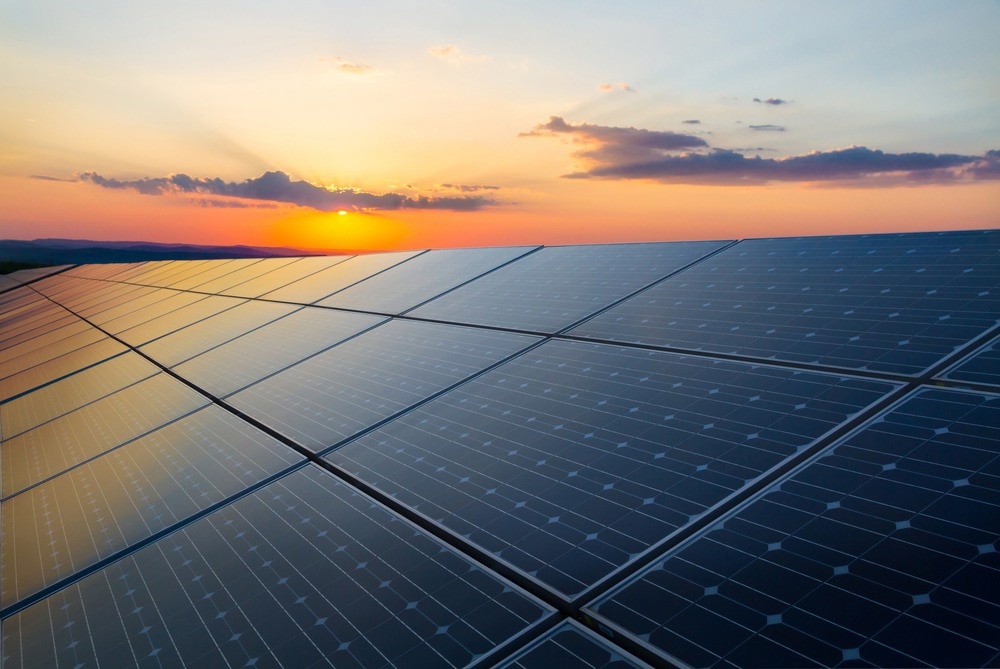This article discusses the relationship between quantum physics and solar cells, exploring how it influences the efficiency of the system.

Image Credit: foxbat/ShutterStock.com
Backgrounds of Solar Cells
In modern society, technological devices permeate our daily lives, offering convenience and comfort. These devices, including cars, mobile phones, computers, and other home appliances, predominantly rely on electrical energy to function. To meet the escalating demand for energy, the world is rapidly shifting towards sustainable renewable energy sources, with solar energy leading the way as a cheap and widely available energy source.
In traditional silicon solar cells, the band gap—the energy difference between the valence and conduction bands—dictates the type of light that can be absorbed. Photons with energy below the band gap pass through the cell. In contrast, photons with higher energy than the band gap can excite electrons but waste the excess energy as heat, limiting the maximum achievable efficiency.
Role of Quantum Physics in Solar Cells
The link between quantum physics and solar cells is crucial, as the conversion of photons to electricity is governed by quantum physics phenomena like the photoelectric effect, quantum tunneling, and energy band theory. For instance, the photoelectric effect is central to the functionality of modern solar cells, as it explains the quantum nature of light-matter interactions and how photons dislodge electrons from semiconductors, producing electric energy.
Similarly, quantum tunneling enables electrons to traverse energy barriers by enhancing charge carrier mobility within solar cells, allowing for more efficient extraction of electrical energy from sunlight.
How Quantum Physics Improves Efficiency?
Quantum physics principles have significantly improved the efficiency and performance of solar cells by leveraging quantum concepts to innovate materials design, optimize device architectures, and enhance light absorption in solar systems.
For example, quantum physics facilitates the design of tandem solar cells, which incorporate multiple semiconductor layers with varying bandgaps to capture a broader spectrum of sunlight. This maximizes light absorption and mitigates losses due to thermalization, enabling higher energy conversion efficiency.
Quantum dots (QDs) also exhibit unique quantum confinement effects that can be exploited to enhance solar cell performance. Researchers can control the electronic properties of quantum dots with high precision and tailor their absorption spectra to match specific regions of the solar spectrum, improving efficiency.
In a recent study, researchers explored the influence of quantum physics on enhancing solar cell efficiency, focusing on utilizing Perovskite Quantum Dots (PQDs) due to their unique properties.
The study highlights recent advancements in employing PQDs in solar cells, emphasizing ligand engineering, additive engineering, and hybrid composition strategies. The findings reveal that PQDs offer improved stability, tunable energy levels, and efficient charge transport, enhancing photovoltaic performance.
Challenges
As solar energy depends on sunlight, it encounters its primary challenge in regions with limited sunlight availability due to weather conditions. Dust accumulation on solar panels can also reduce the output of the solar system. To address these challenges, a feasibility analysis before installation, along with proper maintenance after installation, is necessary.
Other limitations, such as scalability issues, cost-effectiveness, and longevity of solar panels, are expected to be reduced with advancements in quantum technology.
Recent Developments
High-Efficiency CsPbI3 QD Solar Cells
In a 2021 study published in Nature Communications, researchers investigated the potential of all-inorganic CsPbI3 perovskite quantum dots for solar cell applications due to their superior efficiency. They developed a hybrid interfacial architecture that combined CsPbI3 QDs with phenyl-C61-butyric acid methyl ester (PCBM), enhancing charge transfer efficiency and mechanical adhesion.
This innovative approach resulted in a record efficiency of 15.1 % in CsPbI3 QD solar cells, among the highest reported. The study also demonstrated flexible CsPbI3 QD photovoltaics with a notable efficiency of 12.3 %, showcasing improved mechanical stability compared to traditional thin-film solar cells.
Optimizing Inter-Subband Transitions in Solar Cells
In a 2020 study, researchers theoretically explored how quantum physics enhanced solar cell efficiency, explicitly focusing on inter-subband transitions in quantum dot intermediate-band solar cells. They addressed the complex interplay between absorption, recombination, and electronic transport using a specialized analytical model rooted in quantum mechanics.
The study highlighted the critical role of controlling the transit rate between the excited state of the quantum dot and the surrounding semiconductor using a tunnel barrier. This strategic barrier management significantly improved current and voltage, offering a promising framework for designing efficient inter-subband transitions in quantum dot intermediate-band solar cells.
Conclusion
The integration of quantum physics principles into solar cell technology has improved the efficiency and performance of solar systems. Researchers have unlocked new avenues for enhancing light absorption, charge carrier mobility, and overall energy conversion efficiency by utilizing phenomena like quantum tunneling.
Recent studies investigating CsPbI3 perovskite quantum dots and inter-subband transitions in intermediate-band solar cells highlight the notable progress in the solar sector.
More from AZoQuantum: An Overview of the Quantum Mechanics of Solar Energy
References and Further Reading
Albaladejo‐Siguan, M., Baird, E. C., Becker‐Koch, D., Li, Y., Rogach, A. L., Vaynzof, Y. (2021). Stability of quantum dot solar cells: A matter of (life) time. Advanced Energy Materials. doi.org/10.1002/aenm.202003457
Cavassilas, N., Suchet, D., Delamarre, A., Guillemoles, J. F., Bescond, M., Michelini, F., Lannoo, M. (2020). Physics of the inter-subband transition in quantum-dot intermediate-band solar cell. SPIE. doi.org/10.1117/12.2543573
Hu, L., et al. (2021). Flexible and efficient perovskite quantum dot solar cells via hybrid interfacial architecture. Nature Communications. doi.org/10.1038/s41467-020-20749-1
Liu, L., Najar, A., Wang, K., Du, M., Liu, S. (2022). Perovskite quantum dots in solar cells. Advanced Science. doi.org/10.1002/advs.202104577
Tabassum, S., et al. (2021). Solar energy in the United States: Development, challenges and future prospects. Energies. doi.org/10.3390/en14238142
Wang, R., et al. (2018). Highly efficient inverted structural quantum dot solar cells. Advanced Materials. doi.org/10.1016/j.cplett.2022.139881
Disclaimer: The views expressed here are those of the author expressed in their private capacity and do not necessarily represent the views of AZoM.com Limited T/A AZoNetwork the owner and operator of this website. This disclaimer forms part of the Terms and conditions of use of this website.